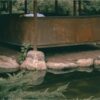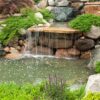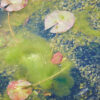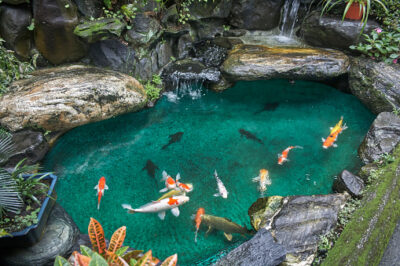How to Feed Your Koi Like Japanese Champions?
Koi (carp), also known as Nishikigoi, is one of the most recognizable fish in Japan.
The fish known as Koi carp is particularly popular among Japanese people and is seen in aquariums and all around the country. For instance, you can find them in private house ponds, temples, and Japanese gardens. It is fair to assume that Koi play a significant role in Japanese culture. But what species of fish are Koi, and how did they become so well-liked in Japan? This article will examine the Koi fish’s secrets from several angles.
What are Koi Fish?

A very well-liked and colorful variation of the Amur carp fish is the Koi (Cyprinus rubrofuscus). These species are frequently kept in outdoor ponds or garden water features as decorative fish. They have a long history in Asian culture that dates back thousands of years, yet despite their coloration, they are not related to goldfish. Any outdoor pond can benefit from its vibrantly colored activities and bright hues.
In outdoor ponds, Koi are frequently housed as pets. Ponds, which frequently have gorgeous rockwork and waterfalls, may be delightful places to enjoy your Koi and perhaps add picturesque scenery to your property.
Koi are temperate freshwater fish that can survive in water that is 45 to 95 degrees Fahrenheit. Koi should be kept at a temperature of 68 to 75 degrees Fahrenheit. Koi can experience various temperatures because deep ponds can keep the water’s thermocline (temperature gradient).
Additionally, Koi will find it simpler to spend the winter in a deep pond. Water up to 18 to 24 inches deep in a pond can freeze. To keep your fish from freezing, ensure your pond is deep enough. When the water temperature exceeds 45–50 F during the winter, Koi will enter a state of dormancy or inactivity. As a result of their body shutting down, they won’t need as much food. Koi can be kept alive over the winter by adding a pond heater to raise the water’s temperature. Certain steps might be taken if your pond freezes over in the winter. Your Koi can survive, for instance, by drilling a hole in the ice and adding an aerator.
Keep in mind that smaller fish will develop with time when choosing the fish for your pond. How many fish can be kept in a pond depends on how big your fish will grow to be as an adult. Typically, 10 gallons of water are needed for every inch of fish. Therefore, a 10-inch fish can live in a 100-gallon pond.
Feeding Your Pet Koi Like Japanese Champions
In an ideal world, we’d all be at the pond feeding our Koi several times a day to resemble how they eat in the wild. Sadly, most of us cannot afford this luxury.

Proper feeding and nutrition are the most important factors in enhancing your Koi’s health, pleasure, and lifespan. Even though we advise auto-feeders, and we’ll explain why in this piece, it’s still crucial that you perform daily gentle hand feeding.
The pastime of keeping Koi has become more enjoyable thanks to automatic feeding technology, yet fun and nutrition go hand in hand.
Depending on what appetizing floats their way, Koi fish will eat a variety of algae, bugs, plant material, and animal stuff in the environment. You must choose what your Koi will eat in captivity, so we’ve listed some suggestions below, along with some treats you can give them at home.
Nishikigoi are less circumspect than the black wild carp, their relative. The reason for their varied behavior is their upbringing. All Koi breeders also produce Nishikigoi. The Koi are already accustomed to being around people when you acquire them because they are raised on Koi farms and fed seven to eight times daily by Koi breeders in order to optimize their size and potential. Koi thinks that all people are kind and would never harm them because breeders all have a gentle demeanor.
Feed your Koi numerous times each day to keep their content as a sign of respect for their beliefs. You might have heard that some people feed their Koi fruits, veggies, and even grains. We’re certain Koi adore them. Personally, I believe it is acceptable to offer your Koi these items. The sole caveat is that cereals should only be given as a rare treat, and any leftovers must be cleaned out.
Koi pellets complete the diets required for Koi’s health and attractiveness. So long as you feed your Koi the right food, they should be fine with these extra treats.
Keep in mind that human foods should only be extra rewards.
When feeding your Koi fish, there are several things to take into account, most of which have to do with the Koi’s body and how their digestive systems are impacted by their environment.
You must first comprehend how the Koi’s metabolism and digestion are affected by these alterations in order to comprehend how the factors that affect their meals function.
Koi are cold-blooded and lack stomachs

Remember, Koi are fish without stomachs. As a result, they are unable to consume a large quantity of food at once and store it in their stomach for processing. They require regular tiny meals.
Humans have stomachs that temporarily store food, allowing us to eat more and allow it to digest more slowly. After eating, we go roughly 5 hours without feeling hungry. However, because Koi fish lack a stomach, they get full very quickly. This is the cause of their constant hunger and their desire to eat small amounts at various times.
The Koi’s ability to digest food is greatly influenced by temperature because they are a cold-blooded species. Your Koi’s metabolism will slow down with increasing cold and speed up with increasing heat. Therefore, during the summer, the Koi are constantly hungry, and during the winter, when it is colder, their capacity to digest food is hindered; they will eat much less or nothing at all.
You’ll discover that feeding your Koi involves a lot of severe factors, which is why auto-feeders are ideal. An auto-feeder can compute the correct amount of food for you based on the feeding schedule and water temperature. Having a safe and secure backup is essential since you cannot always be close to your Koi Pond to monitor the changing variables listed below.

Koi Feeding Amount and Frequency Variables
Here are a few things to think about when choosing how often and how much to feed your Koi. You’ll quickly determine the feeding requirements for your pond based on the temperature, the size of your Koi, and the water quality.
1. The size of the food
Feed your Koi fewer bits of food as they get smaller. The Manda Fu Koi Food can be divided into smaller pieces for hand feeding. A larger Koi will require more food than a smaller or younger Koi fish.
2. Period
Some places have abrupt seasonal or feeding variations, such as intense summer heat and very cold winters. Other climates are far more moderate, and their year-round feeding schedules may be more regulated. Know your region’s environment; regular upkeep is always necessary to get your Koi pond ready for the spring.
Please keep in mind that once winter arrives, Koi go into hibernation. They go without food for the entire winter. Therefore, they must consume and stockpile as much food as they can during the summer. They frequently enter the winter in poor health if they don’t consume enough, which may cause illness in the spring.
Why is the water’s temperature crucial when feeding Koi?
This is so that Koi can eat what and how frequently depending on the water temperature. Keep in mind that because your Koi are cold-blooded fish without stomachs, the production of digestive enzymes in their intestines is temperature-dependent. Don’t put your Koi’s life in danger!
Koi need oxygen for digesting;
Weather can affect the amount of oxygen present. Your Koi’s ability to digest food decreases as the oxygen in your pond decreases. Some people advise against feeding Koi during or shortly after a storm since the water’s oxygen content is at its lowest. You should feed your Koi less when your oxygen levels are low.
Remember that Koi fish poop more when they eat more by keeping in mind that water quality and pumps have an impact on oxygen content. Please keep an eye on both water quality and temperature during the feeding season. Always maintain a healthy range for your water’s parameters.
Again, your Koi won’t be able to digest food to the best of their capacity if the oxygen level in the water decreases. You’ll also run into the same issue if your pump stops working. To prevent your Koi from getting sick or losing the ability to digest food properly, you must make sure the water is of suitable quality.
How Much Do I Feed My Koi?
It is recommended that Koi only consume as much food as they can consume in around 5 minutes at a time.
We often advise clients to feed their fish only as much as they can consume in 5 to 10 minutes. If there are any leftovers, kindly remove them. Your water quality will be ruined if you leave uneaten food in the water.
As previously established, because Koi are cold-blooded animals, the temperature significantly impacts how well they digest food. If you keep the following in mind, you can successfully change your Koi’s feeding schedule.
Koi Need To Be Fed, But an Auto-Feeder Can Do It for You!

Every expert knows that feeding Koi consistently is essential!
Breakfast is eaten in the morning, lunch is eaten at noon, and dinner is eaten at night. Additionally, we typically eat each meal at the same time. Koi are intelligent; they discover who feeds them and why. When they believe they ought to be nourished, they demand food. Therefore, please be consistent about when to feed your Koi in order to get the most advantage from their food.
All Koi Breeders in Japan employ Auto-Feeders
With auto-feeders, not only can you feed your Koi around midday, but also you can also feed them as often as you like — whether you are around or not. Your Koi will get the food the same amount of food at the same time every day – which is the best scenario for growing healthy, happy Koi.
Additionally, suppose you reside in a location where the water temperature dips below 50 during winter. In that case, it is vital that you feed your Koi as much as you can before that shift happens – so that they can hibernate for a long and healthy winter.
Advantages of auto-feeders
We personally advise the auto feeder due to its numerous advantages:
- 1. Put it anywhere; powered by solar or electricity. It first comes with either solar power or an electrical cord. Therefore, a power source by your pond is not really necessary. Where you must place your feeder is not governed by any rules.
- Simple Programming Allows for Scheduled Feedings. Additionally, 12 feedings each day can be programmed. Plus, you may set the width, length, and duration (as well as the amount of food) of each feeding.
- It Encourages Your Hand-Feeding Koi Relationship. We do advise you to feed yourself at least once a day, even if you have an automatic feeder. Being able to hand feed when you are not available is fantastic, but having an auto feeder should give you “peace of mind.”
- Keep in mind that hand feeding is a crucial part of Koi care as it allows you to keep an eye on your fish’s activity and assess their health. The Koi benefit the most from sensing your concern.
- Obtain consistency and tranquility of mind. The ability to feed your Koi as frequently as you choose, even when you are not at home, is the final significant advantage of an auto feeder.
Ending Note
Since ancient times, Koi have been closely associated with Japanese traditions and culture. Koi have long held the attention of many people around the world. Japanese people think Koi are as valiant as the samurai of old and possess powerful attributes that everyone wishes they had in them.
Feed your Koi as they do in Japan, and who knows, you could have your own giant samurai swimming in your backyard pond!









Thanks for sharing!
With Pleasure !